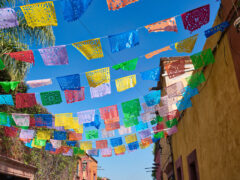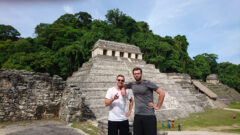Private Journeys
Signature Mexico: Cultural heartlands to Caribbean coast
15 days from £4,420pp
(based on two people sharing & excluding flights)
Itinerary
 Map
Map
Day 1
Arrive in Mexico City. Transfer to central hotel.
You’ll be met at the airport by one of our local representatives and accompanied to your hotel. Mexico City, known by the local people simply as ‘DF’ (Distrito Federal), was built on the site of Tenochtitlan, the capital of the Aztec empire, and it lies at 2,250m above sea level. Vast, chaotic and vibrant, this sprawling megalopolis of more than 20 million people has a multitude of attractions.

Stay at -
Zocalo Central
Day 2
Guided city tour of Mexico City and the pyramids of Teotihuacan
Mexico City has evolved over the centuries into a modern day metropolis from its founding as the Aztec city of Tenochtitlán in the 14th century. A history of agricultural cultivation, religious ritual, and warring tribes took a seismic turn with the arrival of the Spanish conquistadores and the development of the city was fuelled by silver mining. This is all reflected in the cultural vestiges apparent all over the modern cay city which you will glimpse during your guided city tour. Visit the vast Zócalo, or main square, monumental Metropolitan Cathedral and the original Aztec remains of the Templo Mayor, which lay beneath the modern city before being uncovered during the construction of the Mexico City Metro.
Passing through the northern suburbs of the capital, you head into the countryside towards the megalithic archaeological site of Teotihuacán which dates from the time of Christ and was once one of the largest cities in the world. Teotihuacán is hugely influential in the historic narrative of modern Mexico and, although it had already been abandoned by the time of the Aztecs, even this great empire held it in awe. Soak up the history as you stroll along the imposing Avenue of the Dead, leading to the vast Pyramid of the Sun, and take the opportunity to climb its vertiginous, ancient steps for a panorama of the ruins and the surrounding countryside.

Stay at -
Zocalo Central
Day 3
Day at leisure with optional excursions
Today is free to explore on your own, or we can offer a range of optional excursions. Possibilities include the magnificent Museum of Anthropology (closed on Mondays). In our view this is one of the continent’s best museums, with presentations representing different regions, each featuring exhibits manifesting society in pre-Hispanic history and the colonial period as well as showing how life is lived in contemporary Mexico.
A visit to the ‘floating gardens’ of Xochimilco, a network of canals lined by fruit and flower gardens and markets, can be great fun – especially at weekends when residents of Mexico City flock to be transported in one of the colourful gondolas where they are serenaded by a mariachi band. You too will have the opportunity to glide through the canals at a lazy pace on one of these ‘trajineras’. Xochimilco was once connected to the Aztec capital of Tenochtitlan (now Mexico City) and was where they grew much of their food. Combined with a visit to Coyoacan and the Frida Kahlo Museum this is a great day out.

Stay at -
Zocalo Central
Day 4
Fly to Oaxaca.
Leave the capital by air and travel southeast towards the southern highlands and the city of Oaxaca, set among arid mountains.
The population in this area is still dominated by people of Zapotec and Mixtec descent, although the town has many examples of well-preserved Spanish colonial architecture, some fine museums and a thriving artistic community, as well as a wonderful climate. The peace and quiet of the cobbled streets is a welcome contrast to the busy capital.
Discover at your leisure the colonial delights of Oaxaca. You can get around easily on foot with the main square (zócalo), and the boulevard of Calle Alcalá being free from traffic. You might visit the city’s government palace, cathedral and Santo Domingo church, as well as its colourful food market. Oaxaca is a centre for Mexican art; there are also opportunities to buy gifts in some of its art and craft shops.

Stay at -
Casa Conzatti
Day 5
Half day guided excursion to the ruins of ancient city Monte Albán.
Head out of town to nearby Monte Albán, the grand Zapotec ceremonial centre. Strategically located on an artificially levelled hill where three valleys meet, the site has superb views over the surrounding area. There is time to explore the pyramids, steep staircases, walls covered with strange carvings, burial chambers and temples. Although there is a theory that the main plaza was a religious ceremonial site, most of the imagery is decidedly militaristic, featuring tortured captives and devastated conquered settlements.

Stay at -
Casa Conzatti
Day 6
Fly to Tuxtla Gutierrez, continue by road to San Cristobal de las Casas.
Fly from Oaxaca to Tuxtla Gutierrez, a dynamic commercial city and capital of the state of Chiapas.
Drive to San Cristóbal de las Casas via a scenic drive through the Sumidero Canyon. The scenery becomes dramatic with some of the canyon walls towering over 800m.
San Cristóbal is a delightful town on many levels. Its striking location in a fertile valley bound by chunky mountains and its pleasant climate (altitude 2,100m) enhance the rustic charm of the graceful baroque and neoclassical homes, churches and public buildings.
But it is the mélange of cultures, Spanish and indigenous, reflected in the markets and craft-shops that is perhaps the biggest draw. A great place to ramble and relax.

Stay at -
Diego de Mazariegos
Day 7
Guided tour of San Cristóbal de las Casas.
Begin your guided city tour at the pretty main plaza in San Cristóbal de las Casas. On the north side of the square is the cathedral, most recently restored in the 1920s after earthquake damage in the 1800s. You’ll also discover the Santo Domingo temple, a 16th century church with a beautiful pink exterior behind which the church is ornately decorated with gilded baroque features.
Browse the local market before travelling to the indian villages of San Juan Chamula and Zinacantán, about 10mins’ drive from San Cristóbal. San Juan Chamula is notable for local costumes: men in grey, black or light pink tunics, and women in blue. The church, a centre for numerous festivals and rituals, is well worth a look-in. The Sunday market is a popular tourist attraction. In Zinacantán, traditional costumes are also still worn: men wear embroidered red jackets and women, blue shawls. Photogenic but ask first!

Stay at -
Diego de Mazariegos
Day 8
Transfer to Palenque (with optional visit to the Olmec heads at La Venta)
Today you’ll be driven from San Cristobal to Palenque, a journey of around 8 hours from the Chiapas highlands all the way down to the lowland jungles which mark the beginning of the Yucatan Peninsula. After a very early start take the mountain highway west towards Tuxtla Gutierrez, the start of the long descent towards the steamy lowlands of Mexico’s gulf coast and the city of Villahermosa.
With advance notice we can organise a detour to La Venta, one of the Mexico’s most distinguished open-air museums. Known for its collection of huge basalt Olmec heads believed to have been carved between 850-700BC, the park also has some intricately carved altars and stelae, set amongst the lush, landscaped tropical grounds. The relics were moved here from their previous location, an island in the Tonalá River, when petroleum was discovered in the late 1950s.
Arrive in Palenque during the middle of the afternoon with time to relax in the lush tropical grounds of your hotel.

Stay at -
Chan Kah
Day 9
Guided tour of Palenque ruins.
Guided tour of Palenque ruins. The Mayan site of Palenque is set on a hill amongst lush green rainforest abundant with monkeys and birdlife, and a majority of the buildings remains unexcavated.
The temples that have been renovated are in remarkably good condition, the most impressive being the Templo de las Inscripciones . Also impressive is Temple 13 that houses a tomb and red-coloured skeleton believed to have been a queen.

Stay at -
Chan Kah
Day 10
Transfer to Campeche on the Gulf of Mexico
Today’s drive to the coastal city of Campeche takes 5-6 hours along the main highway. The first few hours from Palenque take you through the tropical lowland plains of Tabasco state, the original seat of the Olmec civilisation. Dotted with palms and farmsteads this is cattle country, although Tabasco is also a major oil producing state.
Reaching the western edge of the Yucatan Peninsula, gulf coastal towns such as Champoton and Seybaplaya are popular resorts for locals escaping the heat. The approach road to the city of Campeche itself skirts the ocean, with some soothing views to prepare you for your arrival in the state capital.
Whilst its outskirts are typically sprawling, the historic core of colonial Campeche is an unsung delight – ever in the shadow of much more visited Merida. It makes for a very attractive stopover for the night. The 18-19th century walled central heart of Campeche is a UNESCO World Cultural Heritage Site – deservedly so. Many of the stately buildings, residences, public offices and churches have been restored, their elegant façades washed with pastel colours reflecting the luminosity of the Caribbean. There’s also a lovely waterfront promenade, along which citizens stroll or cycle at sunset.

Stay at -
Hotel Plaza Campeche
Day 11
Continue to Mérida, in the Yucatan heartland.
It’s another 3 hours to Mérida, capital of the state of Yucatán. The city was founded by the Maya and named Tiho. In 1542 it was conquered by the Spanish conquistadores who dismantled the Mayan pyramids and used the stones as foundations for the cathedral.
Mérida then became an immensely wealthy city, described as the ‘Paris of the New World’. Its money came mainly from the production of sisal, cactus fibres that are used to make rope, and it was culturally and geographically isolated from the rest of the country until transport infrastructure reached it in the 1950s.
Today Mérida retains a lovely colonial centre, with a mix of opulent and crumbly buildings but it is a modern, bustling, thriving city, with lots of local character, some excellent places to eat and good shops and markets. The inhabitants, descendants of the Maya and the colonists, love a good fiesta, and you may well find one going on, with live music and market stalls, while you are there.

Stay at -
Hacienda Merida
Day 12
Optional guided excursion to Mayan ruins of Uxmal and Kabah.
We recommend you take an optional guided excursion to the Mayan temple complex at Uxmal, 80km from Mérida.
The site is dominated by the majestic Pyramid of the Magician, alongside which is an elegant ‘nunnery’ quadrangle with Puuc-style complex stonework pieced together like a jigsaw puzzle. Strolling through the ruins, cradled in dense vegetation shading the visitor from the scorching sun is an almost mystical experience. Continue to Kabah, with its incredible Palace of Masks, with intricate mosaics representing the face of Chac the rain god 260 times.

Stay at -
Hacienda Merida
Day 13
Transfer to Chichén Itzá. Guided visit to the ruined city.
From Mérida drive to Chichén Itzá (3 hrs), the grandest of all the Mayan sites, dominated by the huge, symmetrical, stepped El Castillo pyramid. The origins of the site are mysterious, and appear to have Toltec as well as Mayan influences.
It has the largest and best-preserved ball court in the Americas: the venue for an ancient ritual game that was played throughout the continent, but which is still not fully understood.
Archaeologists have not been able to determine whether the losers or winners were decapitated, but judging from the gory carvings along the base of the court’s walls, someone certainly came to an unpleasant end. There is also a huge sacred well. In the evening there is the option to return to the site for the Sound and Light Show.

Stay at -
Hacienda Chichen
Day 14
Option to re-visit the ruins. By road to Playa del Carmen, Mayan Riviera.
Drive to Playa del Carmen on the Mayan Riviera (4hrs). As its name suggests, this stretch of white-sand coastline has been comprehensively developed for tourism, with varying degrees of success from an aesthetic point of view. Cancún is a sprawling resort of high-rise hotels and Disney-like themed bars and restaurants.
As you head south towards Tulum, the built up area thins out and there are some lovely exclusive hotel properties. Playa del Carmen, an hour’s drive south of Cancún, is a pleasant family resort with a lively pedestrianised centre overflowing with restaurants and bars.
If you fancy some beach-time, we recommend you extend your stay here for a few days. There are loads of activities and excursions, from visits to Mayan ruins to scuba diving.
These are easy to book locally. You might even hire a car for a day or two to have more flexibility to explore.

Stay at -
Petit Lafitte
Day 15
Transfer to Cancún airport for international flight home.
Outline itinerary
Day 1
Arrive in Mexico City. Transfer to central hotel.
Day 2
Guided city tour of Mexico City and the pyramids of Teotihuacan
Day 3
Day at leisure with optional excursions
Day 4
Fly to Oaxaca.
Day 5
Half day guided excursion to the ruins of ancient city Monte Albán.
Day 6
Fly to Tuxtla Gutierrez, continue by road to San Cristobal de las Casas.
Day 7
Guided tour of San Cristóbal de las Casas.
Day 8
Transfer to Palenque (with optional visit to the Olmec heads at La Venta)
Day 9
Guided tour of Palenque ruins.
Day 10
Transfer to Campeche on the Gulf of Mexico
Day 11
Continue to Mérida, in the Yucatan heartland.
Day 12
Optional guided excursion to Mayan ruins of Uxmal and Kabah.
Day 13
Transfer to Chichén Itzá. Guided visit to the ruined city.
Day 14
Option to re-visit the ruins. By road to Playa del Carmen, Mayan Riviera.
Day 15
Transfer to Cancún airport for international flight home.
Inspired by this trip
Our exciting range of articles on Latin America explore everything from iconic destinations and lesser-known cultural gems to delicious traditional recipes. You’ll also find exclusive travel tips, first-hand client reviews and the chance to get your personal questions answered by our travel experts.
Papagaio
Your edit for Latin American inspiration
Our exciting range of articles on Latin America explore everything from iconic destinations and lesser-known cultural gems to delicious traditional recipes. You’ll also find exclusive travel tips, first-hand client reviews and the chance to get your personal questions answered by our travel experts.
View Extraordinary Inspiration






































